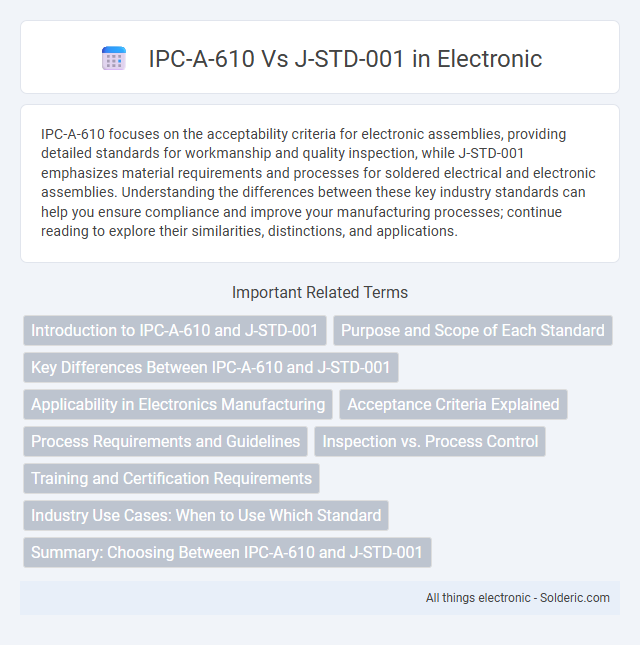IPC-A-610 focuses on the acceptability criteria for electronic assemblies, providing detailed standards for workmanship and quality inspection, while J-STD-001 emphasizes material requirements and processes for soldered electrical and electronic assemblies. Understanding the differences between these key industry standards can help you ensure compliance and improve your manufacturing processes; continue reading to explore their similarities, distinctions, and applications.
Comparison Table
| Aspect | IPC-A-610 | J-STD-001 |
|---|---|---|
| Purpose | Acceptability of electronic assemblies | Requirements for soldered electrical and electronic assemblies |
| Scope | Visual standards for electronic assemblies | Materials, processes, and requirements for soldering |
| Focus | Inspection criteria, defect classification, product acceptability | Soldering quality, process control, workmanship standards |
| Users | Inspectors, quality control personnel | Manufacturers, assemblers, soldering operators |
| Industry Applications | Electronics manufacturing, PCB assemblies quality assurance | Electronics manufacturing, aerospace, military, medical devices |
| Document Type | Visual acceptability standard | Process and workmanship standard |
| Revision | Latest: IPC-A-610G (Sept 2020) | Latest: J-STD-001L (June 2020) |
| Certification | Certification programs for inspectors available | Certification programs for workers and inspectors |
Introduction to IPC-A-610 and J-STD-001
IPC-A-610 is the industry standard for the acceptability of electronic assemblies, providing detailed criteria for manufacturing quality in printed circuit boards and soldered connections. J-STD-001 specifies requirements for materials, methods, and verification of soldered electrical and electronic assemblies to ensure reliability and performance. Both standards are critical in electronics manufacturing, with IPC-A-610 emphasizing inspection acceptance criteria while J-STD-001 focuses on process control and workmanship.
Purpose and Scope of Each Standard
IPC-A-610 sets the acceptance criteria for electronic assemblies, defining visual standards to ensure quality and reliability in soldered connections and component placement. J-STD-001 provides requirements for soldered electrical and electronic assemblies, focusing on materials, processes, and workmanship to achieve consistent soldering results. Both standards complement each other by addressing different aspects of electronic manufacturing quality and process control.
Key Differences Between IPC-A-610 and J-STD-001
IPC-A-610 primarily provides acceptability criteria for electronic assemblies, focusing on visual inspection standards, while J-STD-001 defines requirements for soldered electrical and electronic assemblies, emphasizing materials, processes, and workmanship. IPC-A-610 categorizes product acceptability into classes 1, 2, and 3, guiding quality levels for different applications, whereas J-STD-001 details process control and verification for soldering reliability and performance. The standard IPC-A-610 is widely used by inspectors and quality control personnel, while J-STD-001 is essential for process engineers and assemblers to ensure manufacturing consistency and compliance.
Applicability in Electronics Manufacturing
IPC-A-610 sets the acceptability criteria for electronic assemblies, providing detailed visual standards used globally by manufacturers, inspectors, and end-users to ensure product quality. J-STD-001 outlines requirements for soldered electrical and electronic assemblies, emphasizing materials, processes, and workmanship to achieve robust interconnections. IPC-A-610 is primarily inspection-focused, while J-STD-001 governs manufacturing processes, making them complementary standards critical to electronics manufacturing.
Acceptance Criteria Explained
IPC-A-610 and J-STD-001 provide detailed acceptance criteria for electronic assemblies, with IPC-A-610 focusing on visual quality standards and J-STD-001 emphasizing soldering process requirements. IPC-A-610 categorizes defects into three classes (Class 1, 2, and 3) based on the product's application and reliability needs, offering clear guidelines for acceptability. J-STD-001 complements this by specifying material, process, and workmanship criteria necessary to meet IPC-A-610's acceptability levels, ensuring consistent assembly quality in manufacturing environments.
Process Requirements and Guidelines
IPC-A-610 and J-STD-001 provide distinct process requirements and guidelines for electronic assemblies. IPC-A-610 focuses on the acceptability criteria for completed electronic assemblies, emphasizing visual inspection and quality standards. J-STD-001 outlines the process requirements for soldering and material selection, detailing manufacturing practices to ensure reliable joints and compliance with industry standards.
Inspection vs. Process Control
IPC-A-610 focuses primarily on inspection criteria for electronic assemblies, providing detailed visual acceptability standards to ensure product quality. J-STD-001 emphasizes process control, defining requirements for materials, methods, and operator skills to maintain consistent soldering and assembly conditions. Together, these standards complement each other by combining rigorous inspection protocols with stringent process control measures to optimize electronic manufacturing quality.
Training and Certification Requirements
IPC-A-610 certification focuses primarily on the acceptability criteria for electronic assemblies and requires personnel to be trained on inspection and quality standards for finished products. J-STD-001 certification emphasizes materials and workmanship standards for soldering processes, requiring comprehensive training on soldering techniques, fabrication, and assembly to ensure process compliance. Both certifications mandate ongoing education and recertification every two years to maintain proficiency and adapt to industry updates.
Industry Use Cases: When to Use Which Standard
IPC-A-610 is primarily used for quality inspection of assembled electronic products, focusing on acceptability criteria for soldered electrical and electronic assemblies in manufacturing environments. J-STD-001 is better suited for establishing process requirements and materials standards related to soldering and assembly practices in high-reliability industries such as aerospace, medical, and military sectors. Your choice depends on whether the emphasis is on inspection criteria (IPC-A-610) or on process control and soldering requirements (J-STD-001) to ensure product reliability and compliance.
Summary: Choosing Between IPC-A-610 and J-STD-001
IPC-A-610 and J-STD-001 serve distinct roles in electronics manufacturing quality, with IPC-A-610 providing visual acceptance criteria for electronic assemblies, and J-STD-001 outlining process requirements for soldered electrical and electronic assemblies. Selecting IPC-A-610 is ideal for inspection and acceptance based on workmanship standards, while J-STD-001 is essential for establishing manufacturing process controls and ensuring product reliability. Understanding the specific application needs, inspection scope, and compliance requirements guides manufacturers in choosing between these standards.
IPC-A-610 vs J-STD-001 Infographic

 solderic.com
solderic.com